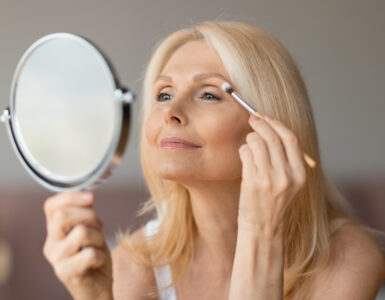Amber Larsen, New Faces Director at McCarty Talent Agency, breaks down the “body talk” language.
______________________________________________________________________
“It’s not what you say, it’s how you say it!” Your body language TALKS. Around 90% of emotion is communicated through body language and voice tone. What you say counts for the other 10%.
<>60% BODY LANGUAGE:
Body language is a term for communication using body movements or gestures instead of, or in addition to, sounds, verbal language or other communication. It forms part of the category of paralanguage, which describes all forms of human communication that are not verbal language. Your body language is about 60% of the way you communicate. This includes the most subtle of movements that many people are not aware of, including winking, slight movement of the eyebrow, and facial expressions. You can review one’s body and tell how you feel. Look at one’s body posture, eye contact, distance/ physical contact, facial expressions, and gestures. Your public image or expressed body language reveals how you feel about yourself.
WHAT DOES YOUR BODY LANGUAGE TELL OTHERS?
Aggressive body language: Showing physical threat, attacking, disruptive
Attentive body language: Showing real interest, alert, fascinated, watchful
Bored body language: Disinterested, indifferent, unconcerned
Closed body language: Cautious, careful, not open-minded.
Confident body language: Feeling secure, sureness, bold, poised
Deceptive body language: Seeking to cover-up, lying, phony, sly
Defensive body language: Protecting self from attack/ alert
Emotional body language: Fervent, impetuous, responsive, hot-blooded, poignant
Empowered body language: Authorized, entitled, immune, qualified, special
Evaluation body language: Judging and deciding about something.
Impatient body language: In a hurry, hasty, anxious, abrupt
Indecisive body language: Unsure, doubtful, wavering, changeable
Interested body language: Attentive, nodding head, intrigued, desirous
Insecure body language: Fidgeting, head bowed, low self-esteem
Open body language: Open-minded, comfortable, assertive
Ready body language: Available, in position, on call, waiting
Relaxed body language: Comfortable, carefree, casual, easy-going
Romantic body language: Charming, dreamy, mysterious, passionate, starry-eyed, tender, visionary
Submissive body language: Lowly, meek, subdued, tame, yielding
We can understand the importance of communicating with our body and make sure we are sending the right message with our gestures. Gestures add authenticity, individuality, and character. Your gestures are as important as your facial expressions. Descriptive gestures illustrate your personality and point. If your arms are folded you are either cold or closed-off. If you are talking with your arms, you are expressive and passionate. If you are uninhibited that suggests openness and confidence.
There sometimes is no difference between body language and wearing a huge sticker on your forehead which reads, “I have low self-esteem!” Who do you think you are fooling? Are your shoulders shrugged up where you can tell you are embarrassed or your palms curled and sweaty? Slouching conveys an attitude of indifference to the world. When you are uptight, you communicate anxiety and insecurity.
Try for a happy medium: poised, and relaxed, assertive but not aloof, comfortable not tense. The human body is programmed to respond with specific emotions when placed in certain situations. Now, we don’t want to be dependent upon other people’s approval; however, we do want to represent ourselves well and confidently. Those of us in business seeking to influence and lead others, what can we take away from this? ‘
Another way to show confidence through your body language is your posture. Posture is an expression of inner attitudes, feelings, and moods. How you carry yourself sends a double nonverbal message. Posture reveals what you think about yourself and what you think about your listener. For greater personal connection and to show greater confidence, you need to pay attention to what you body is telling someone. When you are conversing face-to-face, are you standing with shoulders rolled back, chin level, body open, directly facing whom you are with, and having strong eye contact? The challenge is to communicate with a strong sense of self, with confidence, and directness.
I have trained girls for fifteen years on this concept and it is easier said than done but not impossible. First, there needs to be awareness of what message your body is sending. For example, when we agree with someone, we tend to look the person right in the eye. But if we disagree, our eyes naturally look away. It happens unconsciously and without deliberate control (the same occurs with our voice pitch). Secondly, you start learning the basic techniques: aligned posture, chin up, one foot in front of another, eye to eye contact, warm smile, open body, relaxed facial expressions, and the desire to communicate.
We decided to put this to the test and in one of my recent seminars we had the models practice interview skills. We had the parents who were available play the strict role of the client. The models one by one practiced strong composure and body language. I explained that usually we all have a nervous twitch. What we did with each girl is bring awareness to how she is communicating with her body and find ways to improve her body language. For some, they would speak fast, others would fidget, some had sweaty palms, lack of eye contact was another, and lastly, some would giggle or slouch. After we practiced this technique of interviewing and re-evaluating we would say their high and low. The high was what they did well and the low was what they need to work on. After this seminar, not only did they walk away with greater awareness but they had a desire to communicate effectively using their bodies.
Now that you can see how your body language conveys your confidence level—be cautious of how you express yourself! Basically, be consciously aware of what your body is saying as you communicate with others. Your body language plays a major role in communication. Begin expressing with your body language the level of confidence you want to achieve! Also educate yourself on the following guidelines below.
TOP TIPS TO HAVING BETTER BODY LANGUAGE:
1. Analyze yourself in the mirror to understand your natural tendencies so you note what you want to improve.
2. Pay attention when being spoken too—nod your head. These are signs of an attentive listener.
3. Don’t cross your arms. This shows that you are close minded.
4. Relax your upper body/shoulders. This shows you are not anxious or stressed.
5. Do not slouch! Sit up straight! Do so in a relaxed manner.
6. Do not fidget, itch your head, touch your face, or wiggle your fingers nervously.
6. Don’t let your nervous twitch be displayed!
7. Practice good posture. Keep your chin and head up. Close your eyes and visualize how you want to stand, sit, and communicate more confidently.
8. Have eye contact. This shows confidence and interest.
9. Smile and laugh appropriately. Respond positively. This shows you have a good attitude.
10. Slow down when speaking. Many people talk too fast when they get nervous.
11. Be aware of the positioning of your hands. Example: Wringing your hands nervously, stuffing hands in pockets, or talking confidently with them sends a message.
12. Don’t be afraid to take up space. You are valued as a human being.
13. Show a positive attitude with your facial expressions and body language.
14. Mirror one another’s body language. This builds a stronger connection and makes people comfortable around you. “You are speaking their language!” Example: If you are a high energy person trying to communicate with a quieter, more reserved person, calm down to make them comfortable when communicating.
15. Understand physical boundaries. Don’t stand too close. Value each others space.
16. Practice these steps in the mirror. Fake great body communication until it becomes a natural technique!!!
17. Be aware not to over exaggerate body language where it looks unnatural and is ridiculously awkward.
Tell us about how your “body language” has effected others.
Email Amber Larsen at ambernewfaces@yahoo.com
or contact the McCarty Agency (801) 581-9292.
By Amber Larsen, © 2007, All rights reserved
_________________________________________________________________________
Amber Larsen, the New Faces Director for McCarty Talent Agency, is a talent-developer, model, actor, and modeling coach. She has worked in the fashion and entertainment industries for over 20 years. Her career began with modeling in her early teens and escalated when she won the title of Miss New York Teen, USA at age 18. Since then her experience has been extensive nationally and internationally with years in print, runway, industrial film, stage, television and as spokesperson for companies such as Liz Claiborne, Switcher and Joy & Fun, Overstock.com, Spa Victoria, Tuscan Hills, to name a few. Because of her expertise and her deep interest for the entertainment industry and love for people, she became the New Faces Director for McCarty Agency and has discovered, developed and molded countless talent careers for the last 13 years; marketing top celebrities to international agencies such as Ford, Elite, IMG, Whilmenia, and Next. Amber’s dream, passion and experience for helping people to develop not only their outside beauty, but also their inside; has led her to coach several seminars and co-write an inside/outside beauty book with Heather Christensen, writer and training developer.
Through all of her accomplishments, Amber feels her greatest is with her three beautiful children. Together they reside in Stansbury Park, Utah.















Add comment